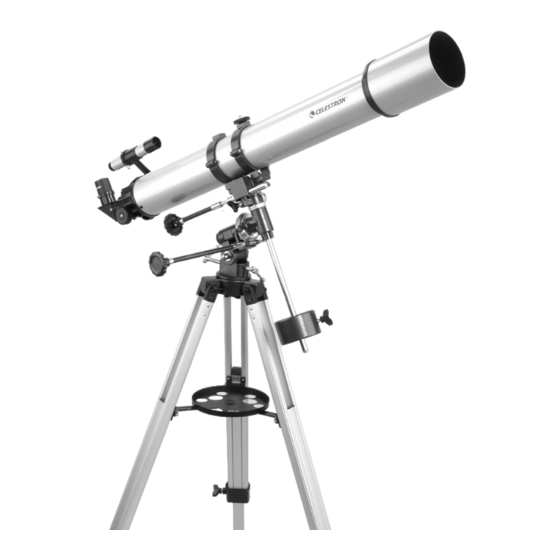
Celestron Ultima 80 Instruction Manual
Celestron power seeker telescope instruction manual eq 80
Hide thumbs
Also See for Ultima 80:
- Instruction manual (48 pages) ,
- User manual (12 pages) ,
- Instruction manual (16 pages)
Summary of Contents for Celestron Ultima 80
- Page 3 Tripod Leg Tightening Screws Latitude Adjustment Screw Thank you for purchasing this Celestron Refractor Telescope. This telescope is a precision scientific instrument. With it you will enjoy numerous objects in the sky—planets, nebulae, star clusters, galaxies and other astronomical objects.
- Page 4 Your Celestron telescope should include all of the following: Tripod with center support bracket b. Telescope tube with tube rings attached Equatorial mount head d. Two 1 ¼" eyepieces 90˚ star diagonal 5x24 Finderscope g. 3x Barlow Lens h. 5# Counterweight...
-
Page 5: Aligning The Finderscope
1. To move the telescope in declination (north/south) there are two options. For large and quick movements, loosen the declination knob (see figure 9) when moving the telescope and then tighten the knob when you are near the position you want. For very small movements and fine adjustments, use the declination cable. The declination cable has a range of about 30°... -
Page 6: Image Orientation
To balance the telescope in DEC: 1. Release the R.A. clamp and rotate the telescope so that it is on one side of the mount (i.e., as described in the previous section on balancing the telescope in R.A.).Lock the R.A. clamp to hold the telescope in place. Release the DEC clamp and rotate the telescope until the tube is parallel to the ground (see figure 6). -
Page 7: The Celestial Coordinate System
Focusing To focus your telescope, simply turn the focus knob located directly below the eyepiece holder. Turning the knob clockwise allows you to focus on an object that is farther than the one you are currently observing. Turning the knob counterclockwise from you allows you to focus on an object closer than the one you are currently observing. -
Page 8: Motion Of The Stars
Latitude Scales The easiest way to polar align a telescope is with a latitude scale. Unlike other methods that require you to find the celestial pole by identifying certain stars near it, this method works... -
Page 9: Pointing At Polaris
If you are observing from Los Angeles, which has a latitude of 34°, then the celestial pole is 34° above the northern horizon. All a latitude scale does then is to point the polar axis of the telescope at the right elevation above the northern (or southern) horizon. -
Page 10: Finding The North Celestial Pole
For example, in the northern hemisphere all stars move around the north celestial pole. When the telescope's polar axis is pointed at the celestial pole, it is parallel to the Earth's rotational axis. - Page 11 4. The right ascension setting circle does not move as the telescope moves in right ascension and thus it must by aligned each time you want to use it to find a new object. However, you do not need to use a bright star each time but you can use the object you are currently observing.
- Page 12 Continuing with our example, multiply the angular field 1° by 52.5. This produces a linear field width of over 52.5 feet at a distance of one thousand yards. The apparent field of each eyepiece that Celestron manufactures is found in the Celestron...
-
Page 13: Celestial Observing
Now that your telescope is set up, you’re ready to use it for observing. This section covers visual observing for both solar system and deep-sky objects. Observing the Moon In the night sky, the moon is a prime target for your first look because it is extremely bright and easy to find. Although the This effect is more noticeable at higher power. -
Page 14: Observing Deep-Sky Objects
Finding them requires a method called star hopping. Celestron Sky Maps (#93722) can help you locate the brightest deep-sky objects. Most deep-sky objects have a large angular size. Therefore, a low-to-moderate power eyepiece is all you need to see them. - Page 15 (stars) appear double. Type 1 seeing is caused by air currents within, or very close to, the telescope tube. These currents are caused by a telescope that has not reached thermal equilibrium with the outdoor surroundings or heat waves from people standing near the telescope.
-
Page 16: Specifications
NOTE: Specifications are subject to change without notice. You will find that additional accessories enhance your viewing pleasure and expand the usefulness of your telescope. For ease of reference, all the accessories are listed in alphabetical order. Exotherm (#93504)- Perfect for chilly evenings outdoors camping, stargazing, or at sporting events, the Exotherm hand warmer is convenient, reusable and made from nontoxic materials. - Page 17 Filters Sets, Eyepiece - Celestron offers four convenient filter sets, which contain four different filters per set. Not only are these highly useful filter combinations, but they also offer an economical way to add versatility to your filter collection. Series 1 – #94119-10 Orange, Light Blue, ND13%T, Polarizing (#s 21, 80A, #15, Polarizing) Series 2 –...
-
Page 18: Celestron Two Year Warranty
Celestron, is found to be defective in materials or workmanship. As a condition to the obligation of Celestron to repair or replace such product, the product must be returned to Celestron together with proof-of-purchase satisfactory to Celestron. - Page 19 Celestron 2835 Columbia Street Torrance, CA 90503 U.S.A. Tel. (310) 328-9560 Fax. (310) 212-5835 Web site at www.celestron.com Copyright 2005 Celestron All rights reserved. (Products or instructions may change without notice or obligation.) Item # 21048-INST $10.00 01-05 Printed in China...

















Need help?
Do you have a question about the Ultima 80 and is the answer not in the manual?
Questions and answers